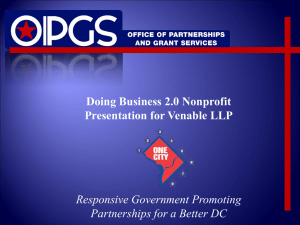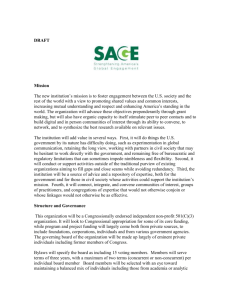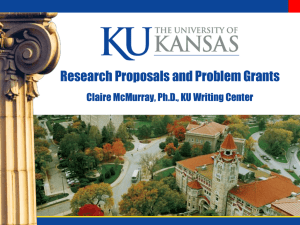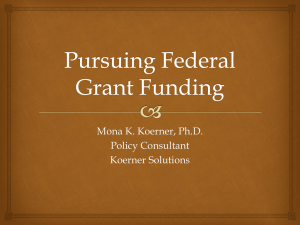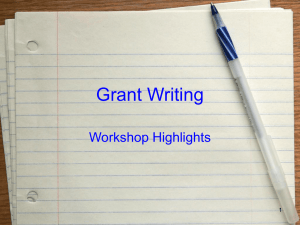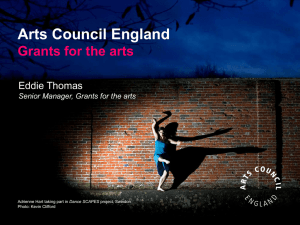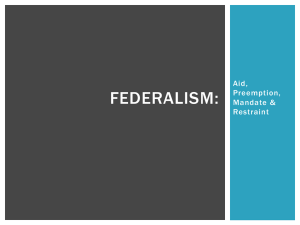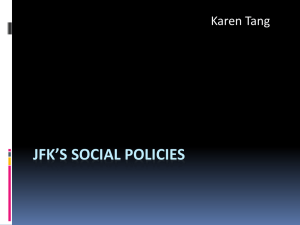Grantsmanship 101: Grant Proposal Writing and Researching
advertisement
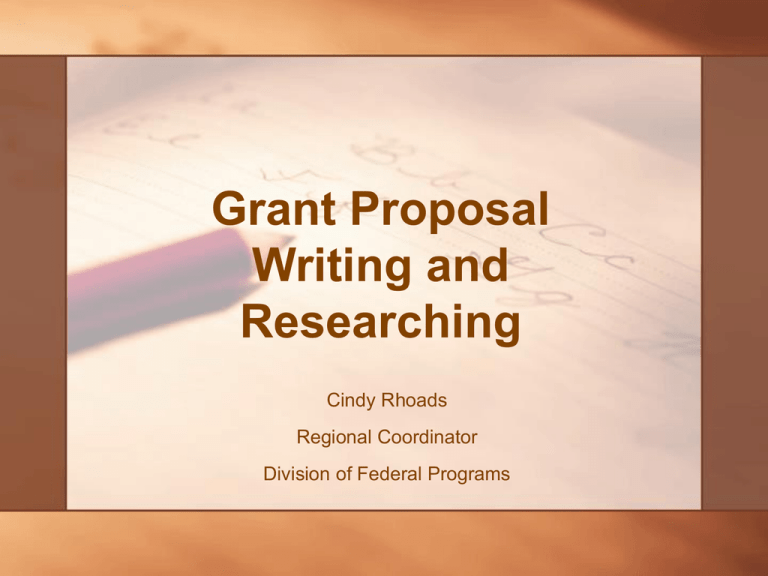
Grant Proposal Writing and Researching Cindy Rhoads Regional Coordinator Division of Federal Programs Worship Goal • Examine the essential components of grant writing and learn how to produce a grant proposal and message that is clear and compelling. • Explore the basis for grant research and learn how to evaluate grants. Agenda • Grant Research – Where to Find Data • Essential Components of Grant Writing • Practice Grant Writing Strategies • Review Sample Grants Types of Grants • Formula • Recipients determined by criteria established by the awarding agency • Allocations are calculated based on a formula usually defined in legislation • Plan required on how funds will be used • Competitive • Awarding agency determines who is eligible to apply • Plans are written and evaluated by a panel of reviewers. Sources for Grants • Federal Government • United States Department of Education • • http://www.ed.gov/news/fedregister/announce/2007-1.html Federal Register • • http://www.gpoaccess.gov/fr/index.html State • State Agencies • • http://www.state.pa.us PA Bulletin • http://www.pabulletin.com/search.asp • Foundation/Private Organizations • Corporate Which one to pick?? BEFORE YOU APPLY FOR ANY GRANT: • Know the Mission of Your Organization • Know the Programs You Administer • Know the Clients You Serve • Review Grant Guidelines • Make sure that your idea precisely matches the grantors criteria. Method of Application • How do you need to apply for the grant? • Online? • • • Obtain Access to the System Review through the system to ensure that you understand how it works. Paper? • Review space limitations and requirements Preparing Grant Proposal • Grants are generally comprised of these sections: • • • • • • • Abstract Needs Assessment Project Goals Implementation Plan Evaluation Plan Budget Additional sections may be added to gain additional information on the particular grants focus. Abstract • Brief overview of the entire project. • First thing the grant reader reads (and scores). • Summarizes information from the needs assessments, goals, activities, evaluation and management plan. • Therefore, from a GRANT WRITER’S perspective, it should be written LAST! Needs Assessment • Systematic review of information collected by a variety of sources, analyzed to determine strengths and weaknesses and prioritized for action. • Beware of “Backwards Engineering” • Foundation of your proposal. • Data, data, data! • • Multiple data sources Easily Measurable Quantitative (test scores, absentee rates, etc.) • Qualitative data (surveys, interviews, focus groups) Where to find existing data… • PDE • BIS/Division of Data Services • • • • eGrant System Other Program Offices • • • Enrollment Attendance Food/Nutrition Nonpublic School Services, etc. For Student Achievement Data: • • • School Improvement Status: www.paayp.com Standard and Poors Bureau of Assessment and Accountability Where to find existing data… • State Level Data • NCES (National Center for Education Statistics) • • • • www.nces.ed.gov Comparison data Demographic data for schools and districts in PA Bureau of Census • Poverty Data State Library Data Resources • Kathy Hale, Outreach Services Supervisor, State Library Project Goals • States exactly what the project intends to accomplish. • All goals must address problems identified in the needs assessment. • • Not all problems (prioritize) A well stated goal will: • • • • • • Specify the problem to be addressed (needs assessment) Be easily measured and demonstrate clear achievement. Specify the target population. Reference local data or standards (not national statistics). Be specific in its time frame but long term in scope Have a realistic and achievable end. Project Goals (Cont’d) • Example of a good goal statement: • • By the year 2009, 70% of 8th graders in the three participating schools, who scored at Below Basic and Basic on the 6th grade PSSA Reading and Math test, will achieve scores at the Proficient and Advanced levels on the 8th grade PSSA. Objectives/Benchmarks • • • Specific and measurable means to achieve each goal. Short term goals should be achievable by the end of the grant period. Long Term goals should have benchmarks set for the end of each year or designated phase of the project to make sure everything is on track to meet the goal by the target timeframe. Project Goals (Cont’d) • Example of an objective/benchmark statement: • • By the end of 2007-08, 35% of 7th graders in participating middle schools who scored at basic or below basic on the 6thgrade PSSA in Reading and/or Math will score at proficient or advanced on the 7th Grade PSSA. Milestones • Checkpoints that measure periodic progress toward meeting the benchmarks Implementation Plan • Details what it is the project will do to accomplish the stated goals. Describes strategies and activities the project will employ. • Implementation Plan will relate to the goals. • “Strategies” are broad approaches (methods, procedures, techniques) and should be research based to show evidence of effectiveness in similar situations. • Every goal should have at least one strategy associated with it. • Examples of strategies include professional development, afterschool programs, mentoring, parent nights, etc. Implementation Plan (Cont’d) • “Activities” are specific steps taken to accomplish the goals. • Activities happen on specific dates and involve direct services to clients. • If “after school tutoring” is a strategy, the days/times it is offered each week is an activity to support it. • Actions that are not activities specifically related to a strategy should be included in the Management Plan instead • • • • Purchasing Equipment Hiring Staff Developing Curriculum Holding Meetings Evaluation Plan • Required to demonstrate project “effectiveness”. • Answers the question “How do I know if this project is successful?” • Most Projects require Ongoing and Final Evaluations • Good Evaluations Plans should include: • • Quantitative Data (test scores, attendance rates, etc.) Qualitative Data (surveys, opinions, etc. • Use your needs assessment as your baseline whenever possible. • Use the same methods of evaluation established in your needs assessment to evaluate your project effectiveness. Management Plan • Describes, schedules and assigns responsibilities for all actions necessary to carry out and support the implementation and evaluation plans. • Who is responsible for what by when? • Cover the entire grant period • Include letters of commitment from partners • Include statements of what the “partners” will commit to in their letters. Things to consider when developing a Management Plan… Will you need additional staff to carry out the proposal? Will you need contracts approved and in place in order to conduct evaluations? Allow processing time What data will the grantor require to be submitted for the project? Surveys Data collection systems, etc. Budget • Should tell the same “story” as the narrative. • Don’t put anything in the budget that isn’t mentioned in the narrative. • Don’t put anything in the narrative that isn’t mentioned in the budget. Peer Review Process • Best way to become a better grant writer is to be a grant reader. • Opportunities: • • • PDE (Classrooms for the Future, Governor’s Schools, School Improvement, etc.) USDE (Small Learning Communities) Mock Peer Review Process Mock Peer Review Process • 2 Proposals from a former EETT Grant Competition • Scoring Rubric • Each reader will read and score two grants. • Use Peer Review Handbook for assistance. • Discussion Grant Overview • Title II.D (Enhancing Education Through Technology) Grants • • • Purpose of grant is to help eligible LEAs obtain and to implement technology and infrastructure to help student achievement. • • • • • $18 million Available 203 grants submitted requesting $76 million Hardware Software Infrastructure (wiring, internet access, etc.) 25% of grant must be used for professional development for teachers. Eligible LEAs: • High Poverty/High Technology Need Process • Read Grants • Using Rubric – score each grant to the best of your ability. • Do you recommend this grant for funding? Questions???

